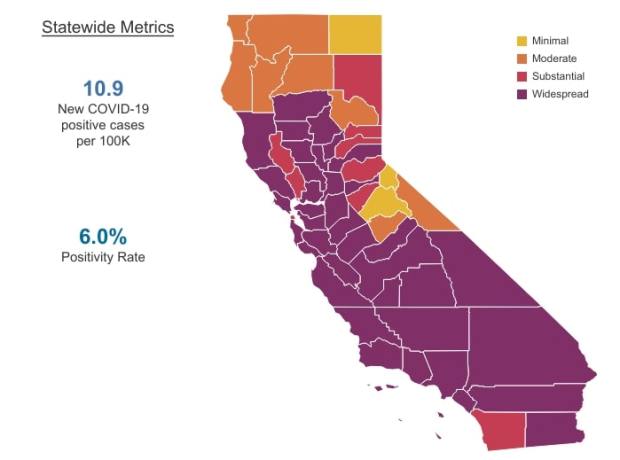Sacramento, CA Andrew Nixon /CapRadio
Gov. Gavin Newsom unveiled a retooled process for loosening and tightening COVID-19 restrictions Friday.
Labeled a “Blueprint for a Safer California,” the system puts California’s 58 counties into four tiers based on the number of new daily cases and the percentage of positive tests.
“We’ve learned a lot the past few months,” Newsom said. “We’re looking now to a uniform framework.”
The tiers are color-coded:

California Department of Public Health
- Purple for Widespread (more than 7 daily new cases per 100,000; more than 8% positive tests; most non-essential indoor businesses closed)
- Red for Substantial (4-7 daily new cases per 100,000; 5-8% positive tests; some non-essential indoor businesses closed
- Orange for Moderate (1-3.9 daily new cases per 100,000; 2-4.9% positive tests; some business operations open with modifications)
- Yellow for Minimal (fewer than one daily new case per 100,000; less than 2% positive tests; most business operations open with modifications).
“We don’t put up green because we don’t believe that there is a green light that says go back to the way things were, or back to a pre-pandemic mindset,” the governor said.
A new state website allows you to look up your county and see what restrictions exist for specific industries and businesses.
The new system allows some businesses to open statewide regardless of what tier a county is in.
Starting Monday, counties in the widespread tier may open some businesses with modifications, including all retail, shopping centers at a maximum 25% capacity, and hair salons and barbershops indoors. Restaurants can only operate outdoors under the strictest tier, but under the substantial (red) tier, they could open at 25% capacity.
Counties in the widespread tier aren’t permitted to reopen schools for in-person instruction unless they receive a waiver from their local health department for TK-6 grades. Schools can reopen for in-person instruction once their county has been in the substantial tier for at least two weeks.
The tier system replaces the state’s previous COVID-19 watch list.
California Department of Public Health
The new plan requires 21 days before a county can move to a less-restrictive tier in order to know what may be adversely affecting public health. And it features a new process for tightening up if and when conditions worsen.
Counties will also be required to provide rates of positive COVID-9 tests and test positivity data and to show they are targeting resources and making the greatest efforts to prevent and fight COVID. Until now, each of the counties had their own rules and were allowed to simply give their word to the state about critical metrics.
Newsom said the new guidelines will allow the state to measure progress against COVID-19 in a more meaningful way.
As of Friday, only three counties — Alpine, Modoc and Tuolumne — are in the yellow or “minimal” category. Sacramento is one of 38 counties in the purple or “widespread” tier. The state has modified the covid19.ca.gov website, allowing you to search for county-specific and business sector-specific information about what services and activities are allowable within that county’s current tier.
